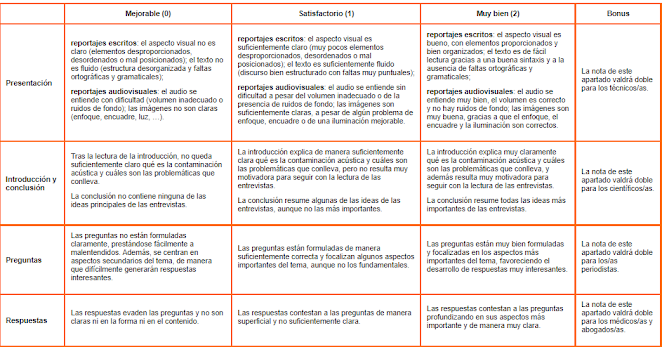Sound, noise and silence.
Noise is usually defined as a unpleasant auditory experience, but this is a subjective definition. The difference between sound and noise is the sort of waves: sound waves are regular and noise waves are irregular.
Noise pollution (CONTAMINACIÓN ACÚSTICA) is produced when the sound volume is too loud. It’s a very common problem in our society and can be harmful to our health. Some of the causes of environmental noise are: transportation, industrial and construction activities, etc. Effects of noise on health include: hearing loss, sleep disorders, stress and aggressive behavior.
Indoor, in the building and outdoor.
Test about Noise Pollution:(1-10)
1 . I pay attention to the noises I usually make.
2 . I avoid noisy places.
3 . I don´t raise my voice when I speak.
4 . I don´t do noisy behaviours at home or school.
5 . I respect my neihbours´ rights to silence.
6 . I lower the volume of my stereo, mp3, walkman, TV, headphones, earphones…
7 . I turn off the television during a meal when I am with my family.
8 . I try to avoid that my dog´s barking doesn´t disturb others. I advice my family not to speak loud or do noisy things.
9 . I know the law concerning noise in my city.
10 . I don´t use my car´s horn unless it´s an emergency.
Lamentablemente, sus consecuencias negativas están muy infravaloradas, a pesar de que son graves y numerosas, sobre todo en países como España, que desgraciadamente está en la cima de la lista de los países más ruidosos del mundo, en el segundo puesto detrás de Japón.
Unfortunately, its negative consequences are greatly underestimated, even though they are serious and numerous, especially in countries like Spain, which unfortunately is at the top of the list of the loudest countries in the world, in second place behind Japan.
Con esta actividad conoceremos estas consecuencias negativas, con particular atención a las que afectan a la salud humana, y realizaremos algunas propuestas para intentar remediarlas, paliarlas o, aún mejor, prevenirlas.
With this activity we will learn about these negative consequences, with particular attention to those that affect human health, and we will make some proposals to try to remedy them, alleviate them or, even better, prevent them.
PROYECT:
El producto final de este proyecto será un reportaje para un medio de comunicación, ya sea un periódico, una radio o una televisión. El formato del reportaje será acorde con el tipo de medio de comunicación elegido, respectivamente: un texto acompañado de imágenes y enlaces, un archivo de audio o un vídeo.
The final product of this project will be a report for a media ,can be a newspaper, radio or television. The format of the report will be in accordance with the type of communication medium chosen, respectively: a text accompanied by images and links, an audio file or a video.
El reportaje contendrá por lo menos:
- una introducción que describa qué se entiende por contaminación acústica;
- una serie de entrevistas a expertos/as sobre diferentes aspectos del tema en cuestión;
- una serie de propuestas para solucionar, paliar o prevenir el problema y sus consecuencias negativas;
- una conclusión que resuma las ideas más importantes tratadas en las entrevistas..
- The report will contain at least:
- an introduction describing what is meant by noise pollution;
- a series of interviews with experts on different aspects of the subject in question;
- a series of proposals to solve, alleviate or prevent the problem and its negative consequences;
- a conclusion that summarizes the most important ideas covered in the interviews.
Proceso-PROCESS
Formamos grupos de cinco personas . Form groups of five people.
Cada uno de los integrantes del grupo asumirá uno de los siguientes roles: Each of the group members will assume one of the following roles:
- científico/a, que redactará la introducción y el cierre del reportaje;
- scientist, who will write the introduction and closing of the report.
- periodista, que redactará las preguntas de las entrevistas y revisará las respuestas y las secciones inicial y final del reportaje para que queden integradas en un estilo suficientemente homogéneo;
- journalist, who will write the interview questions and review the answers and the initial and final sections of the report so that they are integrated in a sufficiently homogeneous style.
- abogado/a, que será entrevistado y responderá a las preguntas relacionadas con los derechos y deberes de las personas y con las funciones y obligaciones de los poderes públicos en materia de ruido;
- lawyer, who will be interviewed and will answer questions related to the rights and duties of people and the functions and obligations of the public authorities in the matter of noise.
- médico/a, que será entrevistado y responderá a las preguntas relacionadas con las consecuencias del ruido en la salud humana, incluyendo algunas medidas para contrarrestar la contaminación acústica y sus efectos negativos;
- doctor, who will be interviewed and will answer questions related to the consequences of noise on human health, including some measures to counteract noise pollution and its negative effects;
- técnico/a, que, además de ayudar al periodista en lo que pueda, se encargará de los aspectos tecnológicos: búsqueda y edición de imágenes libres de copyright; maquetación y diseño web; grabación y edición de audio o de vídeo; etc.
- technician, who, in addition to helping the journalist as much as possible, will take care of the technological aspects: search and editing of copyright-free images; layout and web design; recording and editing of audio or video; etc.
Algunas partes del trabajo se realizarán en clase. Para las demás, dependiendo de la tarea específica a realizar, es aconsejable reunirse presencialmente o utilizar alguna herramienta de trabajo colaborativo, como un documento de Google Drive compartido entre todos los miembros del grupo.
Evaluación
Para la evaluación se tendrá en cuenta tanto el trabajo del grupo como el individual de cada miembro. La calificación final de cada alumno/a se conseguirá calculando la suma de la puntuación obtenida en cada apartado según la siguiente rúbrica.
Dependiendo del rol asumido, cada miembro del grupo recibirá puntuación doble en uno de los apartados.
Conclusión

Tras haber realizado este proyecto ya sabes muchas cosas sobre la contaminación acústica y los daños que el ruido puede ocasionar a la salud y a la convivencia de las personas.
Ten muy en cuenta esos conocimientos, pues te ayudarán a proteger tu salud y la de los demás, además de respetar el derecho a la paz y al descanso de las personas que te rodean.
También te servirán para no olvidar nunca que, a pesar de que el ruido es invisible y de que la mayoría de sus consecuencias negativas suelen manifestarse a medio o largo plazo, cuidar tu oído y protegerlo de los ruidos es muy importante para que siga funcionando bien durante toda tu existencia, permitiéndote disfrutar de una buena vida social, de los sonidos de la naturaleza y naturalmente de la música también cuando seas mayor.
Recuerda que el buen ambiente sonoro es responsabilidad de todos y todas.

No hay comentarios:
Publicar un comentario